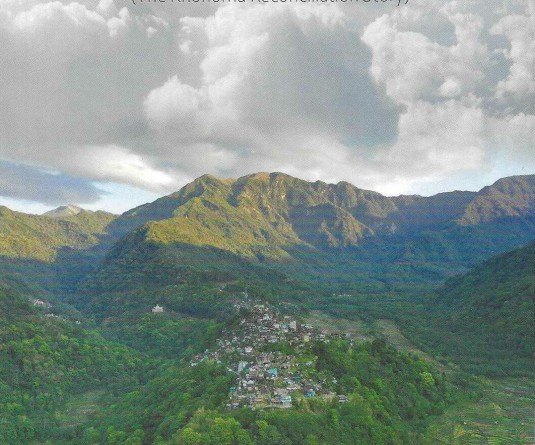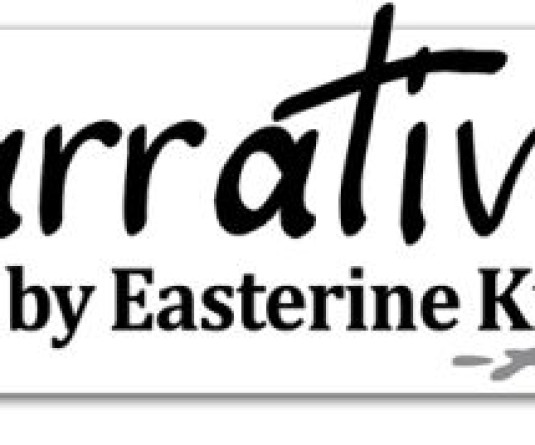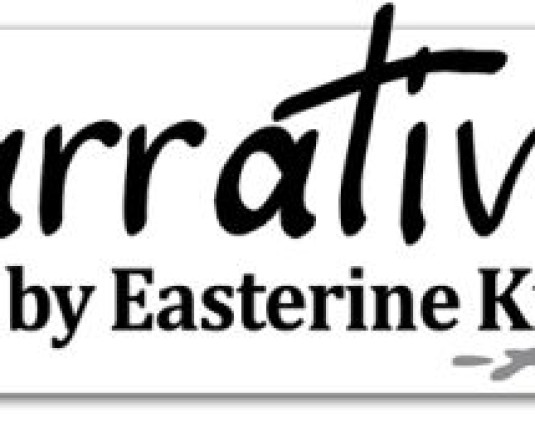
Easterine Kire
One way of describing Dr Veio Pou’s debut novel, Waiting for the Dust to Settle, is to call it a revisiting of a historical time, a historical event that confounded the Naga people first by its brutality, and consequent upon that, by the government apathy in extending justice to the victims of Oinam and its neighbouring villages. With the story of Oinam as its core, the writer brings other landscapes into play.We are introduced to the protagonist’s home village and the kaleidoscope of village life is painted in rich detail.
The action largely takes place in the neighbouring village of Phyamaichi and it unveils the landscape of community: the gatherings of its members at Christmastime, fishing and hunting trips, and the warmth of community life with its agricultural festivals and gatherings on winter nights. It is a warmth that town life does not have because it does not have the organic bonding that is intrinsic to village life. It is also a story of great change. In his own words, Veio states:
‘This novel presents the experiences of a people through the eyes of a young boy who grows up in the course of the novel, and who describes how they cope with the many changes that affect their society in different ways. The novel also incorporates the narratives of individuals who were deeply affected by events in the late 1980s and early 1990s. In one way or another, all members of the closely knit society were affected by the actions of others. All their stories form the larger history of the people, the untold one which is stealthily contributing to filling up the missing pieces of the fragmented history of these people.’
On the 9th July, 1987, the Underground Naga army attacked the Assam Rifles post at Oinam Hill village in Senapati district and looted all the arms and ammunitions stored there. Thereafter the infamous Operation Bluebird was launched to recover the looted weapons in a comb and search operation. But Operation Bluebird was a cover by which the villagers of Oinam were subjected to innumerable violations of human rights by the armed forces. Women were raped, men were killed and survivors were maimed for life. The village of Oinam became the scapegoat and the army took out its anger on the villagers. Neighbouring villages like Phyamaichi and Khungdei experienced army brutality when their numbers were tortured and confined within the village for days. This period was to go down in history as the darkest time for Oinam and her neighbours.
As Veio’s book opens, the young protagonist Rakovei takes us through his childhood in the town of Senapati where he and his friends witnessed army trucks regularly driving past on the highway beside his house. Rakovei’s earliest memories of the Indian troops are the sight of soldiers in their camouflage green uniforms, holding automatic weapons. It was an image that left an indelible impression on the young boy’s mind, an impression of the power wielded by the soldiers. Not many years later, he would discover the extent to which the soldiers would use those powers. It was a very real demonstration of the AFSPA (Armed Forces Special Powers Act) as the villagers, including many of Rakovei’s relatives, were beaten and tortured and killed.
The author takes a political theme and presents a human story of loss, grief, great pain and impotence. It throws up again the reality of army occupation of the Naga hills which is denied in many educated circles today. Recently, a researcher was asked to change or delete the word ‘occupation’ in a book review. This book makes the reality of history inescapable. It is a history that will not appear in official records because it is undocumented and lives only in the memories of those who lived it.
In the book, unwritten history has a central narrator in the figure of the grandmother of Rakovei. Her lament is,
“Hei, people of this generation don’t care about knowing or learning stories that have made us what we are!.Maybe it’s their pursuit of modern education that has taken away all their interest in the stories of old. But they do not know that they are more than just stories. They are our history. When we grew up, it was a matter of pride to be able to sing songs and narrate tales. We were encouraged to learn them as it was essential to our way of education. But these days, all you do is read from books and write in them. I don’t know what is written in them. Do they tell us about our people? Do they tell you stories like I tell you?”
The role of the community’s memory keeper has fallen on Grandmother, and on more than one occasion we find her narrating village history to the young Rakovei. They unearth hidden stories from the Second World war such as the accounts of the wounded Japanese soldiers who did not join their units after they were tended back to health by the villagers. The same soldiers picked up Naga ways and learned the language of the villagers and were adopted into the community.
These and many stories make up Grandmother’s repertoire. Sadly, as occupation of their village by the Indian army continues, Grandmother’s narrative falters and the stories that their present is filled with become almost too heavy to tell. It is up to the new memory-keeper, the writer, to pick up the threads and complete the story.
One reality is that the army comes and tortures and kills and leaves. But it does not stop at that. Survivors of army tortures live the rest of their lives as a burden to their families. Medical treatment costs the family their lands and fields. The price for staying alive is very high. Yet what alternative is there?
Waiting for the Dust to Settle is a powerfully written book about our political history; it is painful, but it has to be told, and if not now, when? It is also a book that says, the political game played by the bigger nation has its casualties. The casualties are not just random people, but whole villages and populations. Human beings are the victims of political actions, both the soldier and the civilian, both the tortured and the torturer. Generation after generation of Nagas feels the effect of the government’s refusal to take away the AFSPA, and provide security to innocent villagers.
The book also chronicles historical tragedies such as the Naga-Kuki conflict of the 80s that took so many lives needlessly, and sowed bitterness and enmity between the two communities. It revisits history and brings it alive by presenting the human element - in the insistence that these events that were undocumented by the national narrative actually took place and altered the destinies of real people and their very real lives.
Dr Pou has answered some questions and shared his writing process:
1. Are there autobiographical elements in this book? How autobiographical is the protagonist or other actions in the book? Is the childhood of the boy reflective of your own childhood?
Well, yes and no. I think all writings have an autobiographical aspect of it. The question is, how much of it should be true to life to qualify as autobiographical? In my novel, almost all my characters are drawn from real people whom I’ve come across. The protagonist shares a lot of my growing up childhood experiences, but as he grew in the novel, he represents many individuals moving along life’s path navigating all sorts of experiences.
But more than the story of one protagonist, what I’ve done in the novel is to bring to fore the life experiences and history of a people and their shared memories. So, in that sense, I would say it is the community that becomes the focal point. What I have tried to do is preserve the community memory of some events in the recent past, though unforgiving they may be at times.
2. You have written an amazing book on the Oinam incident and brought out an insider’s perspective of the grim reality of the Indo-Naga conflict. What are the thoughts you have had on seeing your book in print after a very long wait?
I think the Oinam incident is one of the least talked about incidents when it comes to Indo-Naga conflict despite the impact it had on the Naga movement. But rather than talking about the two confronting parties, I was interested in foregrounding how the lay people suffered because they were caught between the warring parties.
It’s been a long wait, actually, for the book to come to print! For once, I began to fear that the voices in the novel would never be heard! But I’m quite relieved now!
3. Do you like the cover photo? Does it work as a representation of what the struggle has done to the landscape?
Initially, I wasn’t quite sure if I liked the cover, but perhaps, that’s because I had imagined a rather different one. But on closer look, I must say that it captures the spirit of the novel with the dust, the barb wire, the army trucks and, of course, the landscape as the background.
4. You are a father of young children, a busy college Professor, a dedicated church member and husband to a working wife: how do you juggle these roles and manage to write?
Well, it’s not easy I must say. But I’ve learned that it’s not so much about “juggling” as such, it’s more of prioritizing. For me, the Bible is my instruction book of life. My first priority is God, then comes family and work and others. In other words, as the Bible tells me to seek God’s kingdom first for every other blessing to follow, I try to do the same in every aspect of life. With that perspective, I’m able to be faithful in my family life, in my work, etc. And so, to that extent, even in my profession, I know that I am called to work faithfully to please the Almighty, not any human boss or authority. I’m thankful for my family for giving me the space to write occasionally.
5. Would you care to share how you went about writing the book, both the creative aspects and the practical aspects of collecting data, finding sources and oral narrators or written sources (such as Nandita and Sebastian’s books and documents?)
I have long wanted to write about some of the events that I’ve covered in the novel. The skeletal framework of the story was completed on summer break but adding flesh to it took a couple of years, including the temptation to give up midway! But then I pulled through with encouragement from family and friends. As far as the historical source for the book is concerned, I consulted few books and articles, one of which was the book The Judgement that Never Came: Army Rule in Northeast India by Nandita Haksar and Sebastian Hongray on the Oinam incident. Besides, I was fortunate to grow up in a culture of avid storytelling – stories of not only the mythical past but also the oral history of the people. I’ve tried to weave a bit of those legacies into the novel.
6. Any plans for a second book? Your readers would be very interested in finding out.
Well, for now, let me just enjoy this book! What comes next, only the future will tell. Haha…






